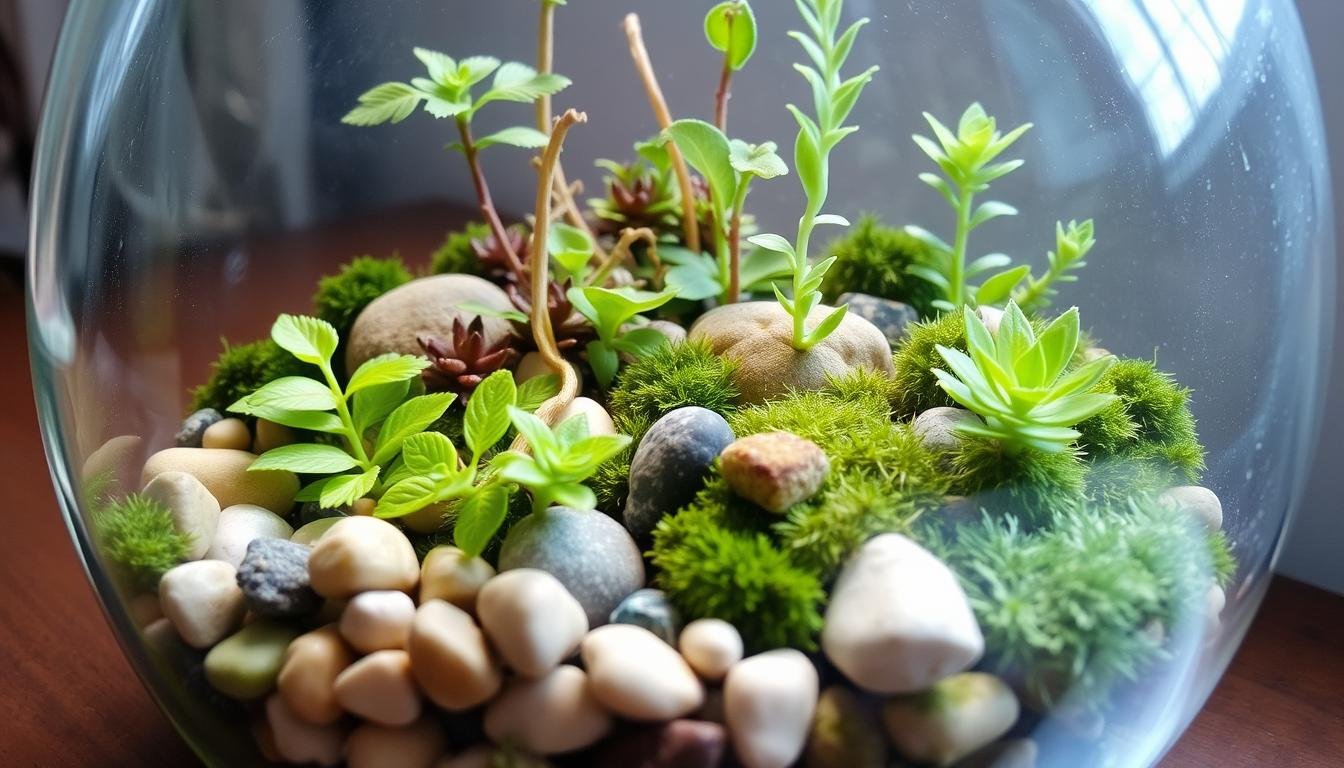Terrarium plants have won over many indoor garden lovers. They mix style with space-saving design. These plants help you grow a lush, vibrant mini garden, even in small spaces.
This section highlights the top terrarium plants. They not only grow well in closed spaces but also make your indoor areas look better. Whether you’re new to gardening or have experience, there are plants that are easy to care for and look great. You can learn more about growing plants in general from this guide. Adding these plants to your space will start your journey to a beautiful mini garden.
Key Takeaways
- Terrarium plants cater to both aesthetic needs and indoor space limitations.
- Creating a mini garden offers a unique form of indoor gardening.
- The curated list includes small plants that maintain their size, making them perfect for terrariums.
- Many plants thrive harmoniously in closed terrarium environments, favoring humidity and indirect light.
- Visual appeal is enhanced through diverse foliage colors and unique textures in plant choices.
Understanding the Appeal of Terrarium Plants
Terrariums are back in home decor, and many are diving into terrarium plants. These small gardens are perfect for indoor gardening, even in tight spaces. They’re loved for their beauty and the chance to have live plants in a small package.
Benefits of Creating a Mini Garden
Terrariums are more than pretty; they offer many mini garden benefits. Making a terrarium is a fun way to show your style and relax. Plus, they’re easy to care for, needing water only once a week.
Why Terrarium Plants Thrive Indoors
Terrariums create the perfect environment for plants, with just the right humidity and light. This makes them self-sustaining. Plus, indoor terrariums are safe from pests and diseases, keeping your plants healthy. Their adaptability makes them great for any space, from homes to offices.
What Makes Good Terrarium Plants?
Choosing the right plants is key to a thriving terrarium. Good terrarium plants grow well and fit their environment. Your choice of plants affects your mini garden’s health and look.
Key Factors for Plant Selection
When picking plants for your terrarium, keep these in mind:
- Size: Pick dwarf varieties that fit your terrarium to avoid overcrowding.
- Humidity: Choose plants that like the same humidity; closed terrariums need moist plants.
- Light: Find species that do well in your terrarium’s light.
- Growth Rate: Select slow-growing plants for a balanced display over time.
Pairing plants with similar needs helps your terrarium thrive. Closed terrariums are great for plants that love humidity. Open terrariums are better for drier plants. Knowing this helps your plants grow well with less care.
Closed vs. Open Terrariums
Closed terrariums keep the air moist, perfect for plants that love humidity. They need less care once set up. Spider plants, snake plants, and ferns do well here.
Open terrariums have better air flow and are easier to access. They’re good for plants that prefer dry air, like air plants.
Knowing what plants need for closed and open terrariums helps your mini garden thrive. For more tips, check out this guide.
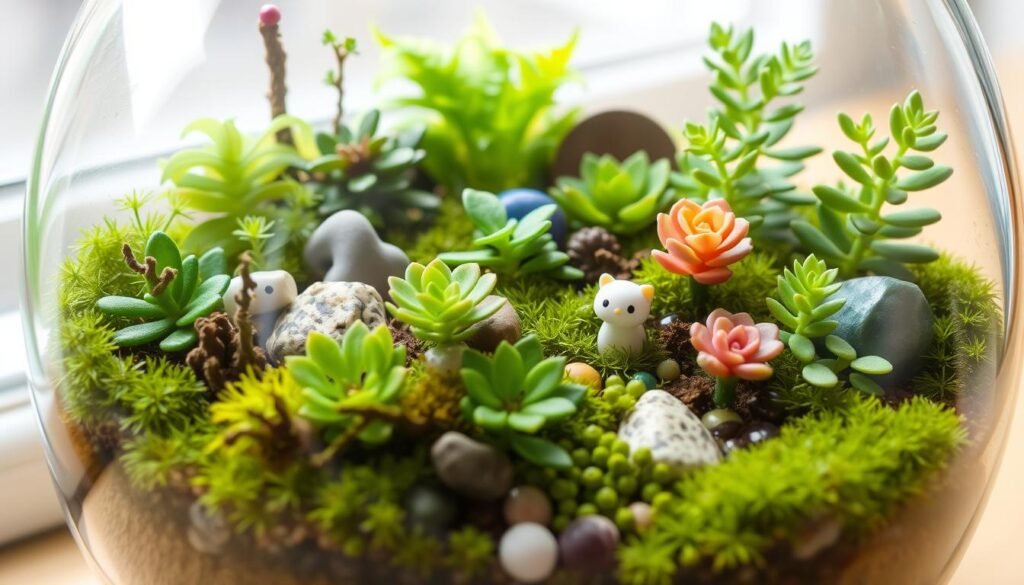
Top Terrarium Plants for Closed Environments
Creating a closed terrarium is like making a mini world. It’s a chance to pick plants that love humidity and don’t need much light. Ferns, Fittonia, and begonias are great picks for your terrarium.
Ferns: Best Choices for Humidity
Ferns love humid places, making them perfect for terrariums. The Boston Fern has bright green leaves and looks lush. It’s a great choice for adding beauty to your terrarium.
The Lemon Button Fern is small and easy to care for. It’s great for tiny terrariums because it can be split into pieces. The Fluffy Ruffles Fern adds texture with its full look. The Heart Fern has heart-shaped leaves and grows up to ten inches, fitting well in different terrarium sizes.
Fittonia: The Nerve Plant Perfect for Terrariums
Fittonia, or the Nerve Plant, is loved for its beautiful leaves. They come in pink, white, and green. This plant is easy to care for and makes your terrarium look amazing.
Choosing the Right Begonia
When picking begonias for terrariums, choose ones that like high humidity and low light. The Friendship Plant has bright green leaves and looks great in terrariums. The Earth Star has bright colors and does well in low light.
These begonias add color and interest to your terrarium. They make your mini world even more beautiful.
Ideal Plants for Open Terrariums
Open terrariums offer a chance to grow a variety of plants that need little water and care. Cacti and succulents are top picks because they’re tough and don’t need much moisture. They’re great for a mini garden. Air plants also work well in open terrariums, adding unique textures and beauty.
Cacti and Succulents: Low-Maintenance Options
Cacti and succulents are easy to care for, making them perfect for vibrant displays. They can store water, so they only need to be watered sometimes. Here are some benefits:
- Variety: There are many species to choose from.
- Size: They come in different sizes, fitting any design.
- Aesthetic: Cacti like Echeveria Secunda add a sculptural touch, making your space look better.
For tips on growing succulents, see this useful guide.
Air Plants: Unconventional but Stunning Selections
Air plants are a great choice for open terrariums. They grow without soil, making them very flexible. Here are some benefits:
- Maintenance: Air plants need only occasional misting, making them easy to care for.
- Variety: There are over 10 species to choose from, giving you many options.
- Texture: They add interesting shapes and colors, changing with each species.
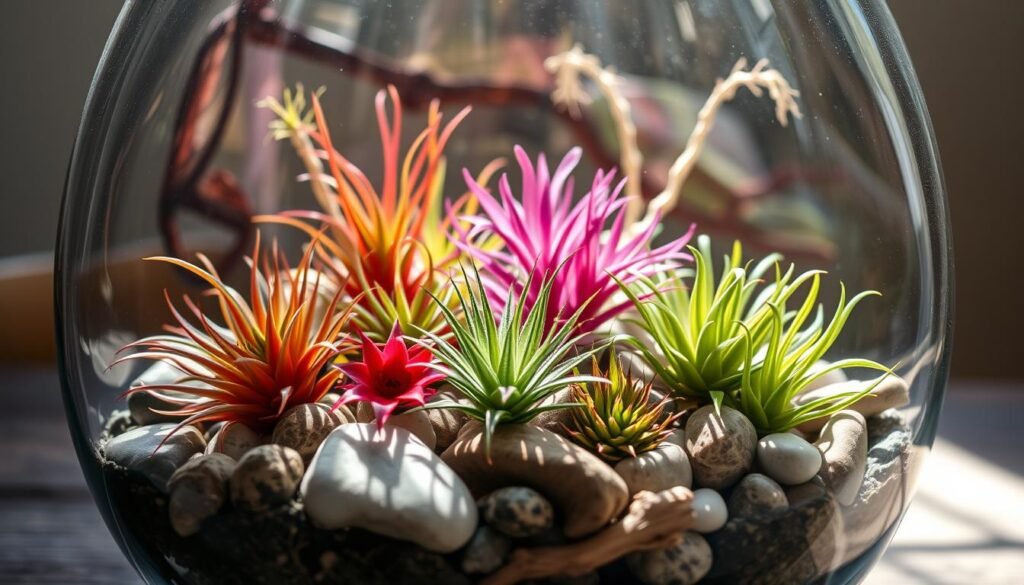
Air plants bring an exotic touch to your terrarium. They do well in bright, indirect light and need monthly fertilizer. Adding them to your terrarium makes it beautiful and easy to maintain.
| Plant Type | Watering Frequency | Soil Requirement | Average Height |
|---|---|---|---|
| Cacti | Infrequent | No | Varies (typically 2-12 inches) |
| Succulents | Infrequent | No | Varies (typically 3-10 inches) |
| Air Plants | Misting every couple of weeks | No | 12-24 inches (varies by species) |
In summary, adding cacti, succulents, and air plants to your open terrarium creates a stunning, easy-to-care-for garden. It will make your space even more beautiful.
Humidity-Loving Plants for Your Mini Garden
To make your terrarium thrive, pick plants that love humidity. The Asparagus Fern and African Violets are great choices. They bring beauty and life to your mini garden. These plants do well in humid environments, making them ideal for terrariums.
Asparagus Fern: An Elegant Choice
The Asparagus Fern adds a soft touch to your terrarium. It can grow up to 2 feet tall and 4 feet wide. Its arching stems make it look lush and soft.
It loves high humidity, making it a top pick for terrariums. With the right care, it stays colorful and adds variety to your terrarium plants.
African Violets: Beautiful Blooms in Terrariums
African Violets add color and beauty to your mini garden. They bloom all year and prefer medium humidity. Make sure to place them carefully to avoid mold issues.
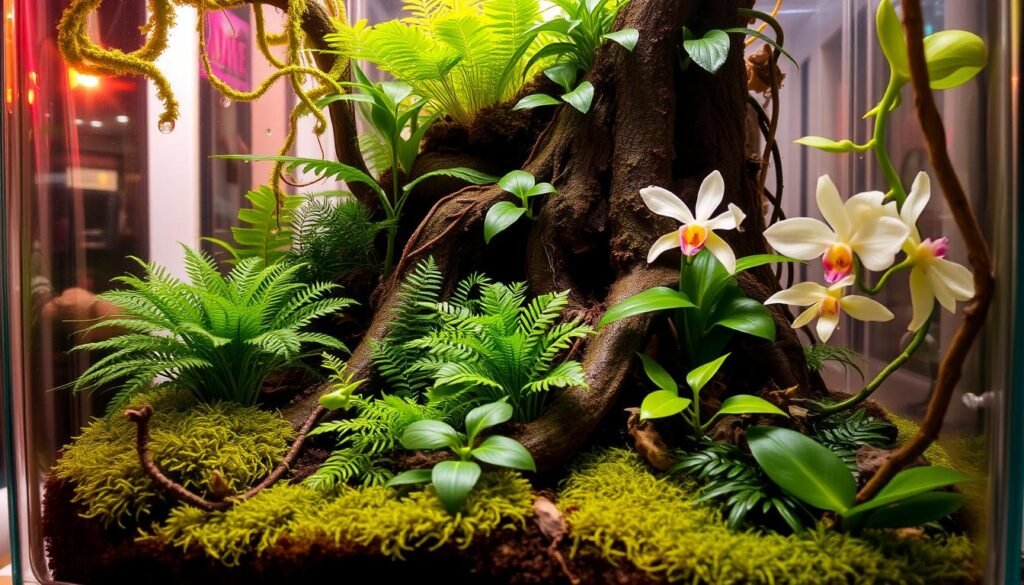
Terrarium Plants with Height: Adding Dimension
Adding height to your terrarium makes it more interesting. Choosing plants that grow tall can make your terrarium look better. These plants help create layers and textures that make your terrarium stand out.
Choosing a Small Parlour Palm
The small Parlour Palm (Chamaedorea elegans) is a great choice for your terrarium. It loves low light and humid places, perfect for indoors. This plant makes your terrarium look like a mini forest, adding a beautiful focal point.
Its slender stalks and arching fronds add a graceful touch. They work well with other plants, making your terrarium look even better.
Asparagus Ferns: A Soft Texture for Vertical Appeal
Asparagus Fern adds softness to your terrarium. Its delicate, feathery leaves bring elegance. It loves humid places, making it great for terrariums.
It looks good with the small Parlour Palm, adding to the vertical layers. Together, they create a welcoming space that makes you want to look up.
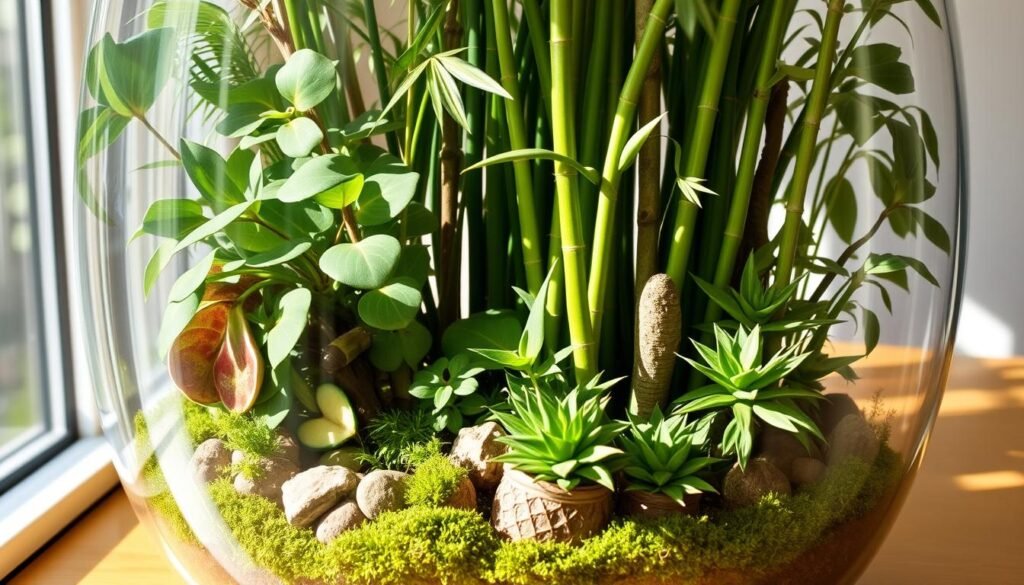
Height and texture are key in a terrarium. The small Parlour Palm and Asparagus Fern not only add height but also help keep moisture in. For more tips on choosing terrarium plants, check out this resource.
| Plant Type | Height | Light Requirement | Humidity Preference |
|---|---|---|---|
| Small Parlour Palm | Up to 4 feet | Low to Medium | High |
| Asparagus Fern | 1-3 feet | Indirect Sunlight | High |
Maintenance and Care Tips for Terrarium Plants
To keep your terrarium thriving, knowing how to maintain it is key. Focus on watering and light exposure, which are critical for plant health. Following specific care tips can help avoid common problems caused by poor care.
Best Practices for Watering and Light Exposure
Watering needs differ for closed and open terrariums. Closed terrariums need watering every 3 to 6 months, based on humidity. Look for dry soil or wilting plants to know when to water. Misting plants instead of pouring water helps prevent overwatering, which can cause root rot.
Light is also very important. For closed terrariums, keep them 1 meter from a north window, 3 meters from east or west, and 5 meters from a south window. This balance prevents too much light and heat. Open terrariums need full or partial sun, best on a windowsill or table, for healthy growth.
Common Mistakes to Avoid
Keeping a terrarium can be easy, but mistakes can happen. Overwatering is a big issue, causing black leaves or mold. Use distilled water and watch for too much condensation in closed terrariums. Avoid fertilizers as they can cause plants to grow too fast and stress the ecosystem.
For more on what to avoid, check out common terrarium mistakes. Knowing these can help keep your terrarium healthy and extend its life.
Terrarium Supplies and Accessories You’ll Need
Building a terrarium needs the right supplies and accessories. The right materials turn your mini garden into a thriving space. Start with a glass container that shows off your plants and helps them grow.
The best supplies make your terrarium look good and work well.
Essential Items for Building Your Terrarium
Here are the key things you need:
- Glass container: You can choose from aquariums and bell jars for a unique look.
- Drainage materials: Use clay balls or gravel to stop water from pooling and rotting roots.
- Activated charcoal: A thin layer keeps the air fresh and prevents bad smells.
- Potting soil: It’s essential for plant life; pick soil that holds moisture but drains well.
For more details, check out this guide on terrarium supplies.
Decorative Touches and Arrangement Tips
Adding decorative elements makes your terrarium look great. Think about using figurines, pebbles, or shells. It’s important to layer your materials right.
Start with drainage, then activated charcoal, followed by soil, and end with your plants. Remember to leave space for air to keep your plants healthy.
These touches make your terrarium a unique reflection of you while keeping it healthy.
| Supply Type | Purpose |
|---|---|
| Glass Container | Holds plants and showcases the terrarium. |
| Drainage Materials | Prevents water pooling and root rot. |
| Activated Charcoal | Maintains air quality and prevents odor. |
| Potting Soil | Supports plant growth while retaining moisture. |
| Decorative Elements | Enhances visual appeal and creativity. |
Choosing the right supplies and accessories lets you create a beautiful terrarium. It’s a mix of practicality and personal style.
Conclusion
Terrarium plants open up a world of gardening right in your home. They make it easy to create a mini garden. This hobby not only beautifies your space but also improves the air and brings peace.
Choosing the right plants for your terrarium is key. This ensures your mini garden thrives. It becomes a living, breathing part of your home.
Starting with terrarium plants is a journey that’s both rewarding and calming. It’s a chance to connect with nature and improve your mood. By embracing this hobby, you can turn your home into a peaceful, green oasis.

